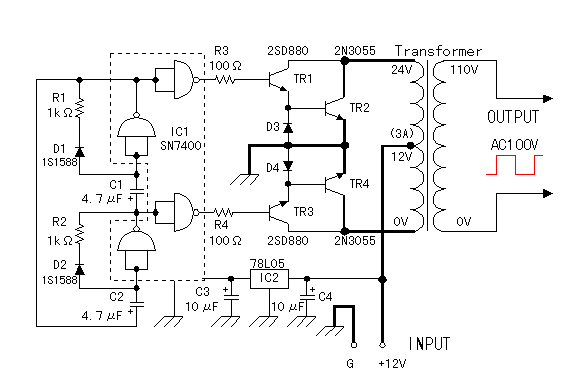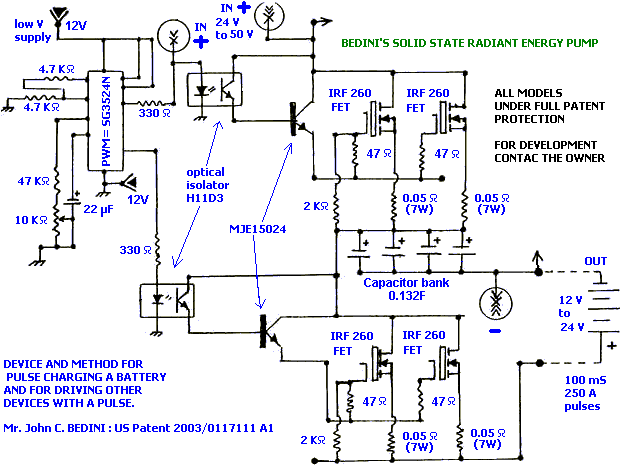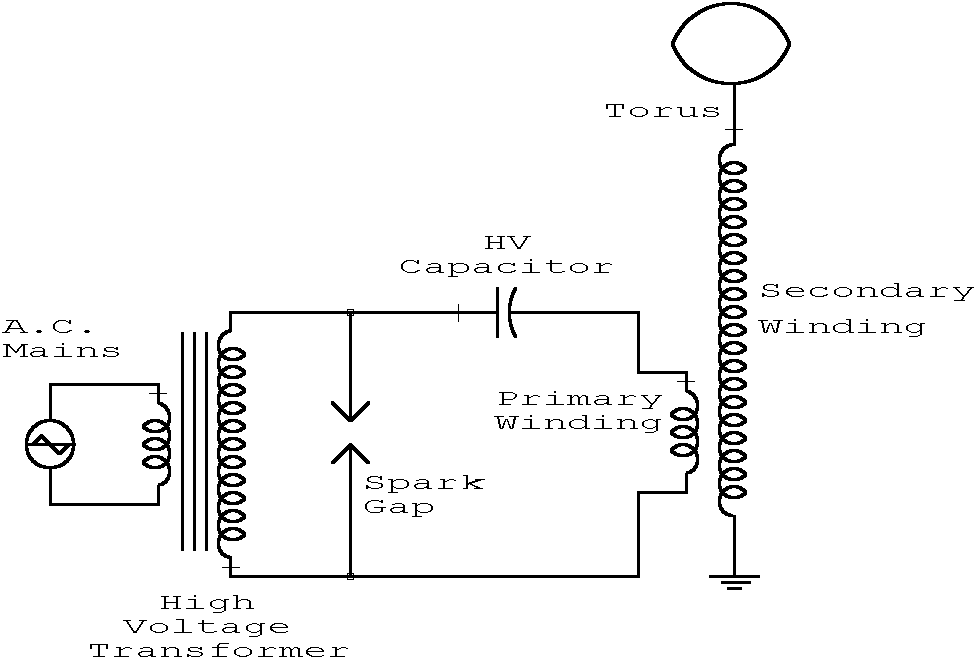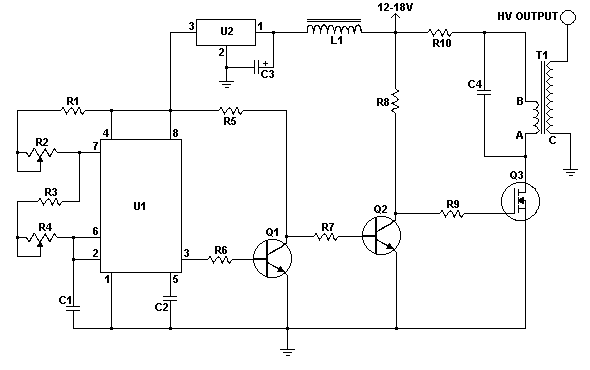
Solid-State Tesla Coil 2
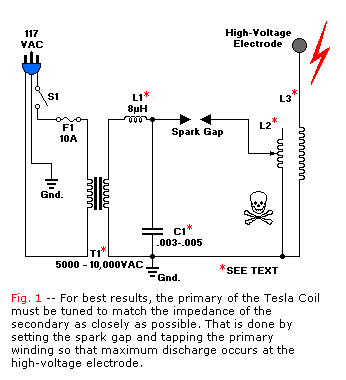
Tesla constructed the world's most powerful radio transmitter. Surrounding the base of a 200-foot mast, he installed an air-core transformer that measured 75 feet in diameter. The primary winding consisted of only a few turns of wire, while the secondary winding was 10 feet in diameter and contained 100 turns of wire. This transformer enabled him to generate approximately 100 million volts. From the 3-foot copper ball atop the mast, bolts of electricity as long as 100 feet discharged; thus, Tesla created the first man-made lightning. With this "Tesla Coil," he was able to illuminate a bank of 200 incandescent light bulbs from a distance of 26 miles. Unfortunately, many reputable scientists of his era dismissed Tesla's ideas as nonsense. Even today, he receives limited recognition for his significant contributions to electronics and electricity. Among his most notable achievements is the development of the AC power-distribution system, which remains in use today. Additionally, there is the high-voltage generator utilized in his Colorado Springs experiments. Scaled-down versions of the Tesla coil are popular among experimenters and hobbyists, providing hours of entertainment when handled carefully. The primary winding is energized by a line transformer that delivers 5,000 to 10,000 volts AC. This transformer is potentially lethal and should be handled with extreme caution. It is advisable to encase the transformer in an insulating plastic housing to protect oneself and curious bystanders. The schematic diagram referenced should not be underestimated despite its simple appearance. Achieving resonance is crucial for the circuit's operation, and this presents a challenge. Working with high-frequency voltages in the 200,000-volt range complicates precise capacitance, voltage, and frequency measurements, which may be difficult to obtain with equipment that is often prohibitively expensive for the average hobbyist. Without accurate data, resonance formulas may prove ineffective, and trial-and-error methods could lead to significant setbacks. The aim here is to provide a framework to assist in the development of a functional Tesla coil; without such a framework, creating an effective model could be time-consuming. With all necessary materials available, a Tesla coil could potentially be constructed in a couple of evenings. However, it is more realistic to expect that the process will take over a week of evenings, especially for those inexperienced in winding long coils of thin wire without overlaps. This article targets experimenters, as previous publications in Popular Electronics and other platforms have provided detailed instructions for building specific Tesla coil designs. The intention here is to offer a foundation for developing a custom Tesla coil design. Design criteria will be presented, along with common pitfalls encountered during the construction process, useful hints to facilitate progress, and suggestions for interesting experiments. The remainder of the project is left to the individual. A heavy-duty hash choke (L1) may be employed to prevent high-frequency electrical energy from entering the AC line and causing interference with televisions, VCRs, and DVD players.
The Tesla coil operates on the principle of resonance, which is achieved by tuning the primary and secondary circuits to the same frequency. The primary circuit consists of the few turns of wire in the primary winding and a capacitor that forms a resonant LC circuit. The secondary circuit, with its 100 turns of wire, also forms an LC circuit with its own capacitor. When the primary circuit is energized, it creates a magnetic field that induces a high voltage in the secondary winding through electromagnetic induction.
The design of the Tesla coil requires careful consideration of the turns ratio, which significantly affects the output voltage. The air-core transformer design minimizes losses associated with the core material, enabling efficient energy transfer. Safety precautions are paramount, as the high voltages generated can be lethal. Proper grounding techniques should be implemented to prevent electrical shock hazards.
In addition to the heavy-duty hash choke, filters may be employed to suppress electromagnetic interference (EMI) generated by the high-frequency operation of the coil. The use of appropriate capacitors and inductors, rated for high voltage, is essential in maintaining circuit stability and performance.
Experimentation with different configurations of the Tesla coil can lead to a deeper understanding of electromagnetic principles and high-voltage phenomena. Various experiments may include adjusting the number of turns in the secondary winding, altering the capacitance in the resonant circuit, or varying the input voltage to observe the effects on output voltage and discharge characteristics.
In conclusion, the Tesla coil is a remarkable demonstration of electrical engineering principles, and with careful design and implementation, it can serve as both an educational tool and a source of entertainment for enthusiasts in the field of electronics.Tesla built the world`s most powerful radio transmitter. Around the base of a 200-foot mast, he placed an air-core transformer that measured 75 feet in diameter. The primary consisted only of only a few turns of wire; the secondary was 10 feet in diameter and consisted of 100 turns of wire.
Using the transformer, he generated on the order of 100-million volts. From the 3-foot copper ball on the top of the mast, bolts as long as 100 feet leapt; Tesla had created the first man-made lightning. And with that "Tesla Coil" he was eventually able to a bank of 200 incandescent light bulbs from a distance of 26 miles.
Unfortunately, Tesla`s ideas were considered nonsense by most of the reputable scientists of his time. Even today, he receives little recognition for his many important contributions to electronics and electricity.
Chief among those, of course, is his development of the AC power-distribution system, which is still in use today. And, of course, there is the high-voltage generator he used for his Colorado Springs experiments. Scaled down versions of that Tesla coil are popular among experimenters and hobbyists. When treated with care, they can provide hours of fun. As mentioned previously, the primary winding is energized by a line transformer that delivers 5000-10.
000 volts AC. Such a transformer is potentially deadly and should be treated with utmost care. It would be more than prudent to house that transformer in an insulating plastic case to protect yourself and curious onlookers. Take a look at the schematic diagram of Fig. 1. Don`t let its simple appearance fool you. For the circuit to work, resonance has to be achieved and that is the catch. When dealing with high-frequency voltages (in the 200, 000-volt range) exact capacitance, voltage, and frequency measurements can be difficult and dangerous to obtain with apparatus that is too expensive for the average hobby lab.
Without that data, resonance formulas are of little help, and trial-and-error-methods can lead you a long way off the path of success. Our purpose here, then, is to provide you with a framework that will help you develop your own working Tesla coil; without that framework, it could take you a long time to develop a good model.
With all the necessary materials on hand (more on that shortly), a Tesla coil could be built in a couple evenings. More likely, however, it will take you over a week of evenings especially if you have no experience in winding long coils of thin wire without overlaps.
Before we go much further, we must make clear that this article is intended for experimenters. Other articles that have appeared in Popular Electronics and elsewhere have given step-by-step instructions for building a Tesla coil of a particular design. Our intension is to provide a starting point for you to develop a Tesla coil of your design. We will present some design criteria, point out some of the pitfalls that we discovered the hard way, give some hints that will help you along the way, and show you some interesting experiments to try.
The rest is up to you. A heavy-duty hash choke (L1) can be used to keep the high-frequency electrical energy from entering the AC line and interfering with TV`s, VCR`s, DVD pl 🔗 External reference
The Tesla coil operates on the principle of resonance, which is achieved by tuning the primary and secondary circuits to the same frequency. The primary circuit consists of the few turns of wire in the primary winding and a capacitor that forms a resonant LC circuit. The secondary circuit, with its 100 turns of wire, also forms an LC circuit with its own capacitor. When the primary circuit is energized, it creates a magnetic field that induces a high voltage in the secondary winding through electromagnetic induction.
The design of the Tesla coil requires careful consideration of the turns ratio, which significantly affects the output voltage. The air-core transformer design minimizes losses associated with the core material, enabling efficient energy transfer. Safety precautions are paramount, as the high voltages generated can be lethal. Proper grounding techniques should be implemented to prevent electrical shock hazards.
In addition to the heavy-duty hash choke, filters may be employed to suppress electromagnetic interference (EMI) generated by the high-frequency operation of the coil. The use of appropriate capacitors and inductors, rated for high voltage, is essential in maintaining circuit stability and performance.
Experimentation with different configurations of the Tesla coil can lead to a deeper understanding of electromagnetic principles and high-voltage phenomena. Various experiments may include adjusting the number of turns in the secondary winding, altering the capacitance in the resonant circuit, or varying the input voltage to observe the effects on output voltage and discharge characteristics.
In conclusion, the Tesla coil is a remarkable demonstration of electrical engineering principles, and with careful design and implementation, it can serve as both an educational tool and a source of entertainment for enthusiasts in the field of electronics.Tesla built the world`s most powerful radio transmitter. Around the base of a 200-foot mast, he placed an air-core transformer that measured 75 feet in diameter. The primary consisted only of only a few turns of wire; the secondary was 10 feet in diameter and consisted of 100 turns of wire.
Using the transformer, he generated on the order of 100-million volts. From the 3-foot copper ball on the top of the mast, bolts as long as 100 feet leapt; Tesla had created the first man-made lightning. And with that "Tesla Coil" he was eventually able to a bank of 200 incandescent light bulbs from a distance of 26 miles.
Unfortunately, Tesla`s ideas were considered nonsense by most of the reputable scientists of his time. Even today, he receives little recognition for his many important contributions to electronics and electricity.
Chief among those, of course, is his development of the AC power-distribution system, which is still in use today. And, of course, there is the high-voltage generator he used for his Colorado Springs experiments. Scaled down versions of that Tesla coil are popular among experimenters and hobbyists. When treated with care, they can provide hours of fun. As mentioned previously, the primary winding is energized by a line transformer that delivers 5000-10.
000 volts AC. Such a transformer is potentially deadly and should be treated with utmost care. It would be more than prudent to house that transformer in an insulating plastic case to protect yourself and curious onlookers. Take a look at the schematic diagram of Fig. 1. Don`t let its simple appearance fool you. For the circuit to work, resonance has to be achieved and that is the catch. When dealing with high-frequency voltages (in the 200, 000-volt range) exact capacitance, voltage, and frequency measurements can be difficult and dangerous to obtain with apparatus that is too expensive for the average hobby lab.
Without that data, resonance formulas are of little help, and trial-and-error-methods can lead you a long way off the path of success. Our purpose here, then, is to provide you with a framework that will help you develop your own working Tesla coil; without that framework, it could take you a long time to develop a good model.
With all the necessary materials on hand (more on that shortly), a Tesla coil could be built in a couple evenings. More likely, however, it will take you over a week of evenings especially if you have no experience in winding long coils of thin wire without overlaps.
Before we go much further, we must make clear that this article is intended for experimenters. Other articles that have appeared in Popular Electronics and elsewhere have given step-by-step instructions for building a Tesla coil of a particular design. Our intension is to provide a starting point for you to develop a Tesla coil of your design. We will present some design criteria, point out some of the pitfalls that we discovered the hard way, give some hints that will help you along the way, and show you some interesting experiments to try.
The rest is up to you. A heavy-duty hash choke (L1) can be used to keep the high-frequency electrical energy from entering the AC line and interfering with TV`s, VCR`s, DVD pl 🔗 External reference

